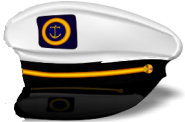Mastering Ship’s Navigation
Continuing the series to enhance the navigational ability of the deck officers on board merchant ships, this article explains the importance of understanding one of the main characteristics of ship navigation– The stopping distance.
Every vessel shows different characteristics when it comes to the distance covered when stop signal is given due to difference in dimensions, loading and ballast condition.
It is very important for a navigating officer to learn the principles of passage planning and understand his ship’s characteristics even as a small mistake in understanding may lead tocollision, grounding or other kind of mishaps.
Stopping distance of ships
As we all know, ship like any other transport utility does not have brakes to make them stop immediately. When the engine is given stop order, the ship will continue moving in the same direction due to inertia and will come to stop after moving for some distance.
Every ship has two different stopping distances depending on:
- Inertia Stop
- Crash stop
Inertia Stop
As described above, when the engine of the ship is stopped, the ship will continue moving in the same direction for some more distance due to inertia. Here no astern command is given (used to produce “braking effect” for ships), and hence ship will travel more distance in the inertia stop method.
Crash Stop
Crash stop is usually the term used when the ship has to sudden stop in emergency situation. Here the engine, which is moving in an ahead direction is given an order for full astern, leaving the rudder in the mid ship position to stop the ship within minimum distance and shortest possible time. To know the complete procedure read for crash stopping read – crash manoeuvring.
In general operation i.e. berthing or departure of the ship from port or manoeuvring through channel or narrow passage, the above two methods are combined for a swift navigation of the ship i.e. in between giving an astern kick to stop and slowing down the ship’s speed for better manoeuvring.
The stopping distance data and chart is given in sea trials of the ship and made handy on bridge for reference. Every deck officer must refer this data to master the navigation of the ship.
The data may differ when used due to variation in weather condition, ships loading, stability and other factors; however, deck officers can compare the trail data and make use of it in practical situations.
Few Practical Examples
Depending upon the loading condition and the speed of the ship, the stopping time will be different when these two conditions are changed.
Also Ships fitted with Diesel machinery will have stopping distances approximately 70% of those fitted with Steam Turbine machinery.
When the ship’s hull has been due cleaning (dry dock) for longer time, the stopping distance and time will be less as compared to when the ship is just out of dry dock. This is because the hull resistance is more in ships with dry-dock done long ago.
The wind direction and sea condition also plays an important role as wind and waves acting from behind the ship will increase the stopping distance and vice versa.
It is important for a navigation officer to know the surrounding of its ship and how the ship will react to change in speed and loading condition. Only then he/she will be able to sail safe through all kinds of seas.
marineinsight.com
